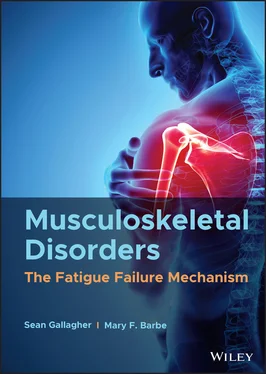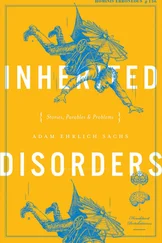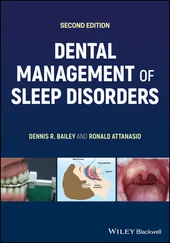Sean Gallagher - Musculoskeletal Disorders
Здесь есть возможность читать онлайн «Sean Gallagher - Musculoskeletal Disorders» — ознакомительный отрывок электронной книги совершенно бесплатно, а после прочтения отрывка купить полную версию. В некоторых случаях можно слушать аудио, скачать через торрент в формате fb2 и присутствует краткое содержание. Жанр: unrecognised, на английском языке. Описание произведения, (предисловие) а так же отзывы посетителей доступны на портале библиотеки ЛибКат.
- Название:Musculoskeletal Disorders
- Автор:
- Жанр:
- Год:неизвестен
- ISBN:нет данных
- Рейтинг книги:5 / 5. Голосов: 1
-
Избранное:Добавить в избранное
- Отзывы:
-
Ваша оценка:
- 100
- 1
- 2
- 3
- 4
- 5
Musculoskeletal Disorders: краткое содержание, описание и аннотация
Предлагаем к чтению аннотацию, описание, краткое содержание или предисловие (зависит от того, что написал сам автор книги «Musculoskeletal Disorders»). Если вы не нашли необходимую информацию о книге — напишите в комментариях, мы постараемся отыскать её.
Hands-on guidance and tools for the prevention of musculoskeletal injuries in the workplace Musculoskeletal Disorders: The Fatigue Failure Mechanism,
Musculoskeletal Disorders: The Fatigue Failure Mechanism
Musculoskeletal Disorders — читать онлайн ознакомительный отрывок
Ниже представлен текст книги, разбитый по страницам. Система сохранения места последней прочитанной страницы, позволяет с удобством читать онлайн бесплатно книгу «Musculoskeletal Disorders», без необходимости каждый раз заново искать на чём Вы остановились. Поставьте закладку, и сможете в любой момент перейти на страницу, на которой закончили чтение.
Интервал:
Закладка:
Assessing Risks of Job Rotation. Job rotation is a technique sometimes used in industry in an attempt to balance the biomechanical demands associated with different jobs. However, a recent award‐winning article in the journal Ergonomics using fatigue failure techniques demonstrated that job rotation may be more harmful than helpful in terms of the overall MSD risk to a pool of workers (Mehdizadeh et al., 2020). Due to the nature of the fatigue failure risk function, any reduction in risk for higher risk jobs is guaranteed to be smaller than the increase in risk experienced by those in lower‐risk jobs (See Chapter 13). The magnitude of this effect will vary from extremely large, if a single high‐risk job is present in the pool, to small if all jobs are fairly low risk. Such an analysis would be difficult to achieve with some prior models but is straightforward using fatigue failure principles.
Influence of Personal Characteristics on MSD Risk. Fatigue failure also offers the potential to incorporate certain personal characteristics into risk assessment. As an example, fatigue failure theory stipulates that the ultimate strength of a material determines the number of cycles to failure at different percentages of that strength. If an individual performs a lifting task resulting in a 2,500 N compressive load on the spine, they will incur damage more quickly if they have a spine ultimate strength of 6,000 N (say at age 60) as opposed to 8,000 N (at age 30). Factors such as age, anthropometry, sex, bone mineral density, and others could be considered to develop “personalized” risk assessments that may be more protective for workers based on their individual characteristics. Risks associated with personal characteristics are discussed in Chapter 12.
The preceding examples provide a sampling of the opportunities that may be realized with the use of the fatigue failure approach to MSD risk, many of which would be difficult to realize with previous approaches. There are numerous other useful applications of this model as will be described in detail later in the book.
In summary, fatigue failure is a universally accepted causal mechanism of damage nucleation and propagation for nonbiological materials, and there is ample evidence to suggest that the same process occurs in musculoskeletal tissues. Much of what has been learned regarding the process of material damage resulting from repeated stress appears applicable to the assessment of musculoskeletal risk, and many techniques developed in this theory appear to provide ready solutions to challenging problems faced by musculoskeletal researchers. These include simple methods of estimating the cumulative impact of multiple tasks having highly variable loading conditions. Techniques are also available for assessing cumulative damage associated with complex loading curves that will be useful soon as real‐time exposure assessment methods for MSDs become available. Furthermore, models incorporating the effects of healing and other biological processes critical to musculoskeletal health have been put forth, thus allowing the complexity of the fatigue failure process in the biological environment to be more fully understood.
As indicated by the earlier discussion, there are many topics to be discussed and implications to be addressed when evaluating the effects of a fatigue failure process in a biological environment and the roles of damage and healing in overall musculoskeletal health. We have structured the 16 chapters in a logical order, and the chapters are grouped into four general themes. Chapters 2– 5provide detailed information regarding common MSDs and the components of the musculoskeletal system, including the structure and function of musculoskeletal structures, the material properties of these tissues, and the important role of nerves and the nervous system in the musculoskeletal system. Chapters 6– 9cover fundamental concepts of biomechanics, evidence of fatigue failure processes in musculoskeletal tissues, and fundamental concepts in fatigue failure analytical methods relevant to the assessment of MSD risk. Chapters 10– 12discuss concepts related to the unique aspects of fatigue failure in a biological environment, addressing the body’s healing capacity and the influence of personal characteristics and psychosocial stress on MSD risk. The final four chapters ( Chapters 13– 16) provide methods for assessing risk using fatigue failure methods, implications for MSD prevention, suggestions for optimizing musculoskeletal health, and assessment of the status of knowledge and the need for future research in this area. We would note that the book need not be necessarily consumed in the order in which it was written, as many chapters can be read on their own without loss of meaning.
Bibliography
1 Bani Hani, D., Huangfu, R., Sesek, R., Schall, M. C., Jr., Davis, G. A., & Gallagher, S. (2021). Development and validation of a cumulative exposure shoulder risk assessment tool based on fatigue failure theory. Ergonomics, 64(1), 39–54.
2 Barbe, M. F., Gallagher, S., Massicotte, V. S., Tytell, M., Popoff, S. N., & Barr‐Gillespie, A. E. (2013). The interaction of force and repetition on musculoskeletal and neural tissue responses and sensorimotor behavior in a rat model of work‐related musculoskeletal disorders. BMC Musculoskskeletal Disorders, 14, 303. https://doi.org/10.1186/1471‐2474‐14‐303. PMID: 24156755; PMCID: PMC3924406
3 Brinckmann, P., Biggemann, M., & Hilweg, D. (1988). Fatigue fracture of human lumbar vertebrae. Clinical Biomechanics, 3(Suppl. 1), S1–S23.
4 Carter, D., & Hayes, W. (1976). Fatigue life of compact bone—I. Effects of stress amplitude, temperature and density. Journal of Biomechanics, 9, 27–34.
5 Dong, R., Wu, J., Xu, X., Welcome, D., & Krajnak, K. (2021). A Review of Hand–Arm Vibration Studies Conducted by US NIOSH since 2000. Vibration, 4, 482–528.
6 Gallagher, S., & Heberger, J. (2013). Examining the interaction of force and repetition on musculoskeletal disorder risk: A systematic literature review. Human Factors, 14, 108–124.
7 Gallagher, S., Marras, W., Litsky, A., Burr, D., Landoll, J., & Matkovic, V. (2007). A Comparison of fatigue failure responses of old versus middle‐aged lumbar motion segments in simulated flexed lifting. Spine, 32, 1832–1839.
8 Gallagher, S., & Schall, J. M. (2017). Musculoskeletal disorders as a fatigue failure process: Evidence, implications and research needs. Ergonomics, 60, 255–269.
9 Gallagher, S., Schall, M., Jr., Sesek, R., & Huangfu, R. (2018). An upper extremity risk assessment tool based on material fatigue failure theory: The distal upper extremity tool (DUET). Human Factors, 60, 1146–1162.
10 Gallagher, S., Sesek, R., Schall, M., Jr., & Huangfu, R. (2017). Development and validation of an easy‐to‐use risk assessment tool for cumulative low back loading: The Lifting Fatigue Failure Tool (LiFFT). Applied Ergonomics, 63, 142–150.
11 Gosain, A., & DiPietro, L. (2004). Aging and wound healing. World Journal of Surgery, 28, 321–326.
12 Guo, S., & DiPietro, L. (2010). Factors affecting wound healing. Journal of Dental Research, 89, 219–229.
13 Kiecolt‐Glaser, J., Marucha, P., Malarkey, W., Mercado, A., & Glaser, R. (1995). Slowing of wound healing by psychological stress. Lancet, 346, 1194–1196.
14 Kumar, S. (2001). Theories of musculoskeletal injury causation. Ergonomics, 44, 17–47.
15 Ma, C., Gu, J., Charles, L., Andrew, M., Dong, R., & Burchfiel, C. (2018). Work‐related upper extremity musculoskeletal disorders in the United States: 2006, 2009, and 2014 National Health Interview Survey. Work, 60, 623–634.
16 Matsuishi, M., & Endo, T. (1968). Fatigue of metals subjected to varying stress. Paper presented to the Japanese Society of Mechanical Engineers. Fukuoka, Japan: Japanese Society of Mechanical Engineers.
Читать дальшеИнтервал:
Закладка:
Похожие книги на «Musculoskeletal Disorders»
Представляем Вашему вниманию похожие книги на «Musculoskeletal Disorders» списком для выбора. Мы отобрали схожую по названию и смыслу литературу в надежде предоставить читателям больше вариантов отыскать новые, интересные, ещё непрочитанные произведения.
Обсуждение, отзывы о книге «Musculoskeletal Disorders» и просто собственные мнения читателей. Оставьте ваши комментарии, напишите, что Вы думаете о произведении, его смысле или главных героях. Укажите что конкретно понравилось, а что нет, и почему Вы так считаете.




![Ally Carter - [Gallagher Girls 02 ] - Cross My Heart & Hope To Spy](/books/262178/ally-carter-gallagher-girls-02-thumb.webp)







![John Bruce - The Lettsomian Lectures on Diseases and Disorders of the Heart and Arteries in Middle and Advanced Life [1900-1901]](/books/749387/john-bruce-the-lettsomian-lectures-on-diseases-and-disorders-of-the-heart-and-arteries-in-middle-and-advanced-life-1900-1901-thumb.webp)